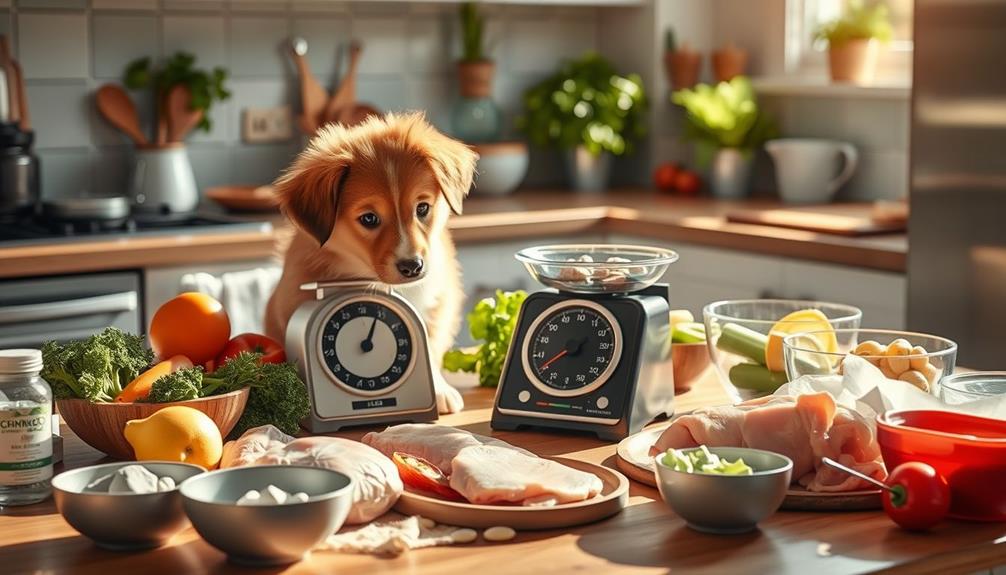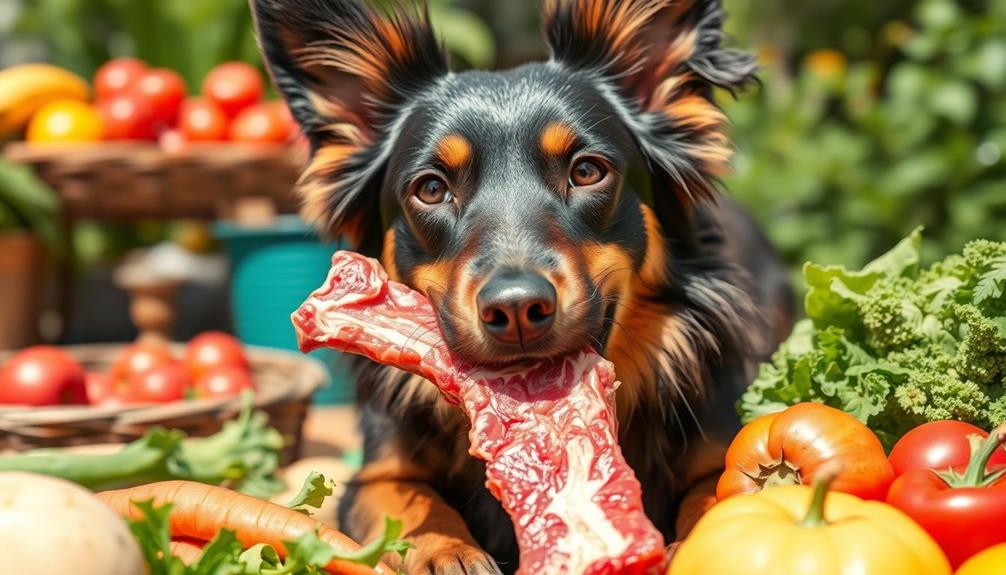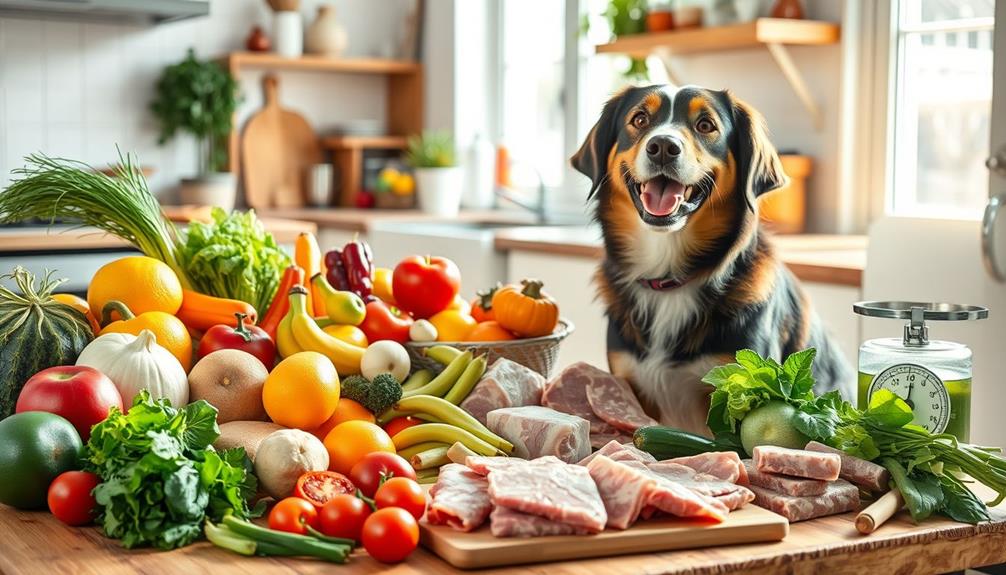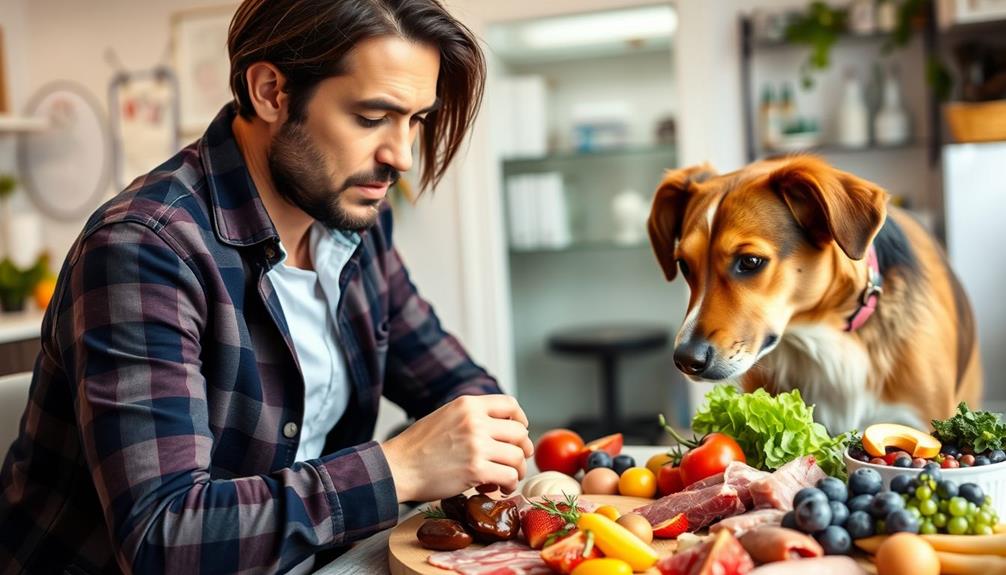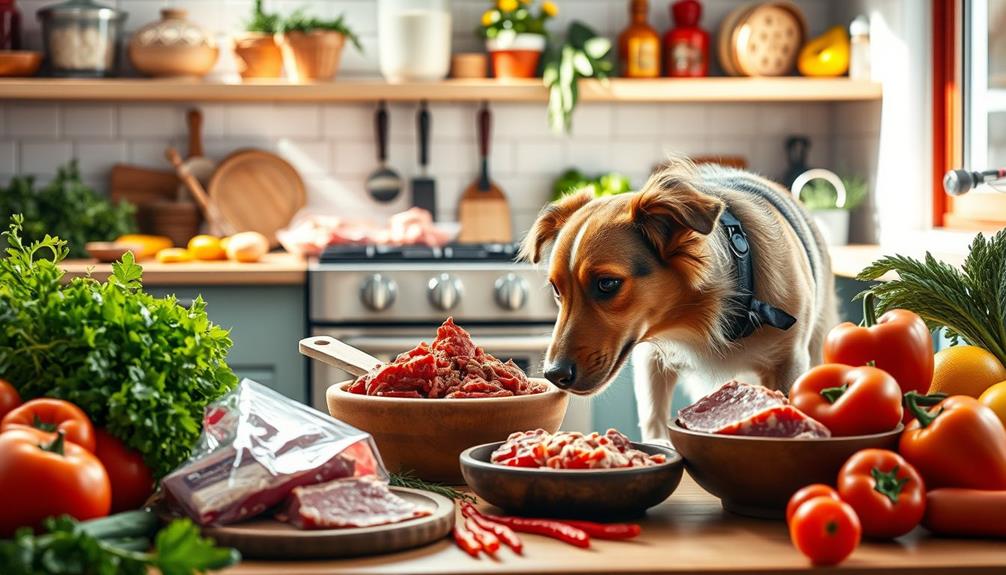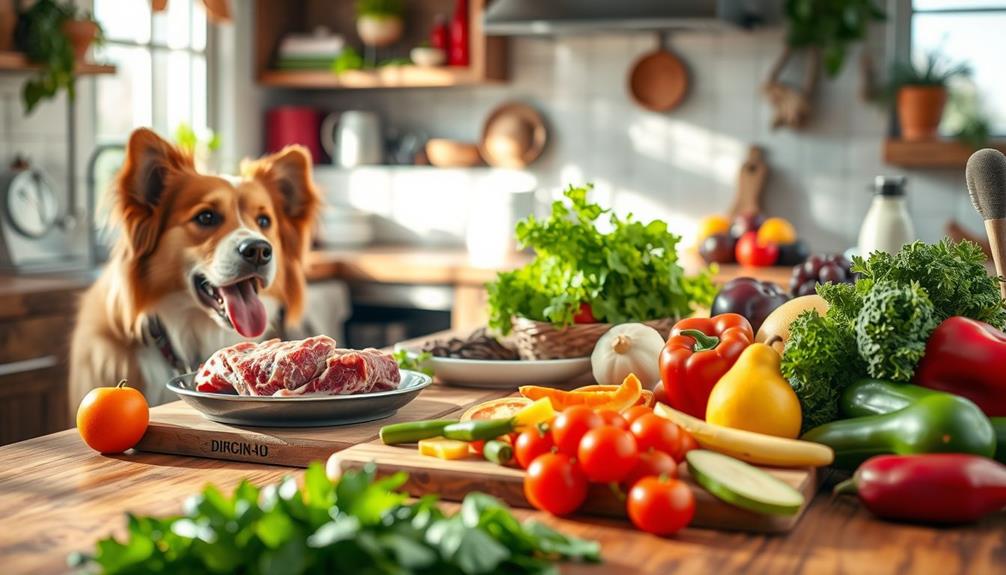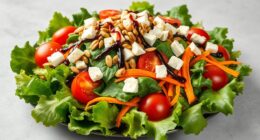To calculate raw food for your puppy, start by weighing them. Use 5-6% of their body weight for daily food in the early weeks, decreasing to about 4% by six months. For a 10kg puppy, that's roughly 500-600g daily. Feed puppies aged 8-16 weeks four meals a day, reducing to three by 16 weeks. Monitor their weight weekly and adjust portions as needed. Guarantee a balanced diet with protein, fat, and fiber. As your puppy grows, keep an eye on their health indicators. Want to discover more about feeding schedules and shifting to raw food? Consider consulting with a veterinary nutritionist, who can provide guidance on how much raw food to feed your puppy at each stage of their growth. They can also help tailor a diet to your puppy’s specific needs and any health concerns. It’s important to be attentive to their development and adjust their raw food intake accordingly. Additionally, research reputable sources and consult with other experienced pet owners to gather insights on how much raw food is appropriate for your puppy.
Key Takeaways
- Determine your puppy's weight and calculate 5-10% of it for daily raw food intake, adjusting based on age and activity level.
- Start with a balanced raw diet, including muscle meat, edible bones, liver, and vegetables for essential nutrients.
- Gradually transition to raw food over a week, mixing current food with raw food in increasing proportions.
- Monitor your puppy's weight weekly and adjust food portions to maintain an ideal body condition score.
- Observe your puppy's energy, behavior, and stool consistency during the transition to identify any allergies or intolerances.
Understanding Puppy Nutritional Needs
When it comes to understanding puppy nutritional needs, you should know that puppies require a markedly higher calorie intake than adult dogs. Typically, they need about 5-6% of their growing body weight in calories daily to support their rapid growth and energy levels.
Puppies thrive on a balanced diet that includes protein, fats, carbohydrates, vitamins, and minerals essential for development and bone health. Puppy feeding must be tailored to meet these specific requirements.
A balanced diet is essential, including protein, fats, carbohydrates, vitamins, and minerals that are important for development and bone health.
You'll start weaning your puppy at around 3-6 weeks, introducing a ground paste that supplements their mother's milk. By 6 weeks, they should be eating fine puppy food to meet their nutritional needs.
At approximately 4 months, it's time to shift to normal formulas, which are significant for their evolving dietary requirements.
Regular weight checks are important to adjust the amount of food accordingly, ensuring your puppy's growth aligns with their age-specific needs.
Whether you're considering a raw diet or commercial food, always prioritize a balanced approach to support their overall health and development.
Calculating Daily Food Amount
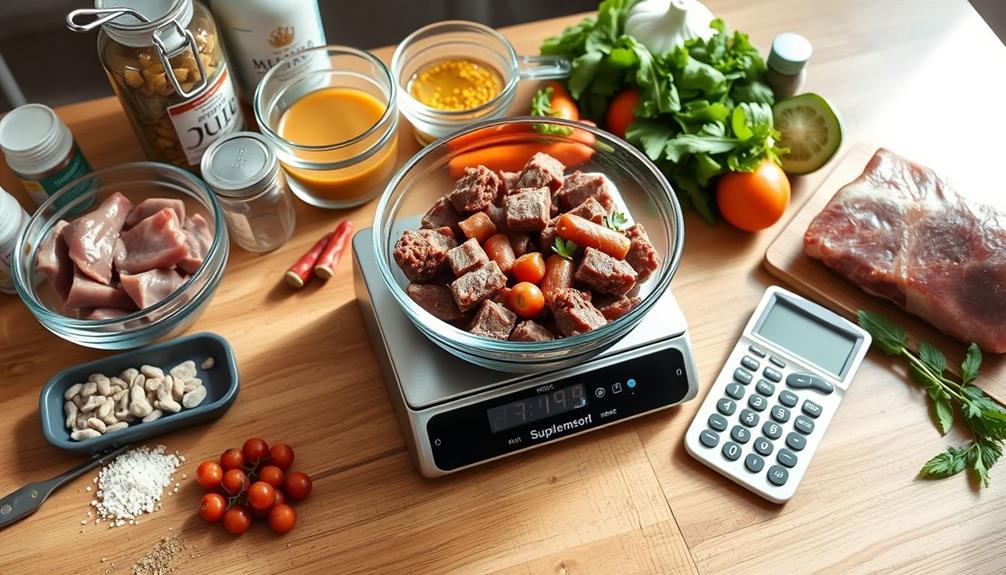
Calculating the right daily food amount for your puppy is essential to supporting their growth and health. To start, you need to determine your puppy's current weight and use that to find the ideal feeding amount.
It's important to also consider any financial considerations for your puppy's care, as budgeting for food is part of overall expenses, much like assisted living expenses for elderly care.
Here are some quick tips:
- Use 5-6% of your puppy's weight during the weaning phase for daily food.
- Adjust the feeding percentage as your puppy matures; by six months, reduce it to about 4%.
- Monitor your puppy's weight weekly to make sure they maintain an ideal body condition.
For example, if your puppy weighs 10kg, you'll need to provide approximately 500g to 600g of food daily based on the 5-6% guideline.
It's vital to utilize feeding charts that correlate age and weight to get accurate food portions at different growth stages.
As your puppy grows, remember that their daily food amount changes, so be prepared to adjust accordingly.
This proactive approach guarantees your puppy receives the right nutrition at every stage, supporting their health and growth effectively.
Feeding Schedule for Puppies
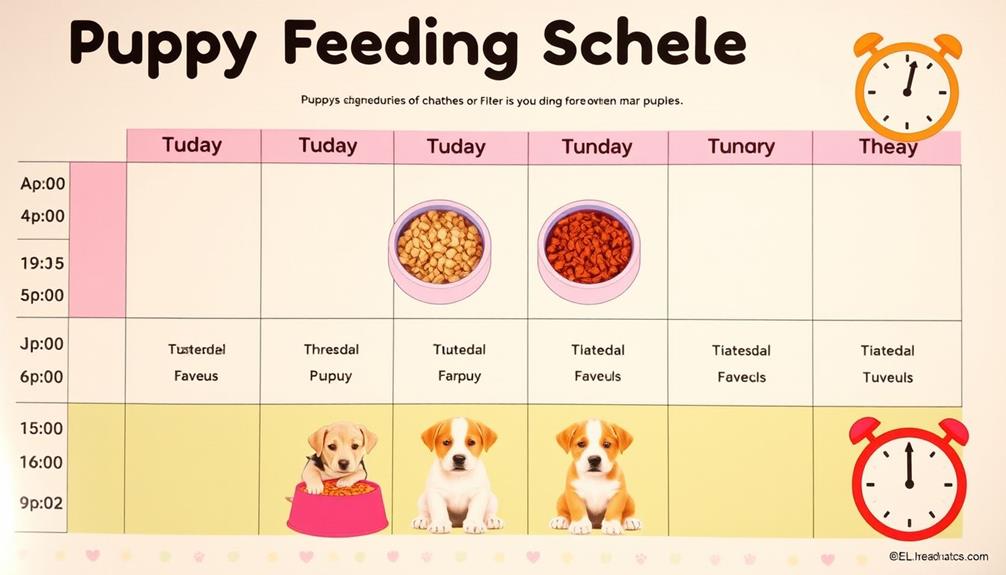
When it comes to feeding your puppy, timing is just as important as the food itself. For ideal growth, you should follow specific meal frequency recommendations based on their age.
Offering healthy dog snacks in between meals can also provide additional nutrients and keep your puppy satisfied.
Understanding these age-specific feeding guidelines will help guarantee your puppy gets the nutrition they need at every stage of development.
Meal Frequency Recommendations
Puppies typically thrive on a structured feeding schedule that meets their growing needs. As you adjust the meal frequency, keep in mind their age, size, and activity level.
It's also essential to guarantee that the food you choose is important for their development, as it markedly impacts their health and growth.
Here's a quick breakdown:
- 8 to 16 weeks: Feed 4 meals per day to support rapid growth.
- 16 weeks to 12 months: Shift to 3 meals per day as their growth rate slows.
- After 12 months: Most puppies can change to 2 meals per day, depending on their size and individual needs.
Regular weigh-ins are important to assess if you need to adjust the feeding schedule or portion sizes.
Remember, the right food to feed your puppy is essential for their development, and providing appropriate meal frequency helps guarantee they get adequate nutrition.
As you move towards feeding your puppy like an adult dog, stay attentive to any changes in their behavior or weight.
Age-Specific Feeding Guidelines
Establishing an effective feeding schedule is essential for your puppy's development. For puppies aged 8 to 16 weeks, you should feed them four meals a day to support their rapid growth needs. This frequent feeding helps guarantee they get the right amount of raw food, typically ranging from 4% to 10% of their body weight.
Proper nutrition during this significant period is essential for key domains of development, including their physical and cognitive growth. As your puppy grows, the feeding frequency can be adjusted. From 16 weeks to 12 months, you can reduce their meals to three per day since their growth rate slows.
Adjusting Food Based on Growth
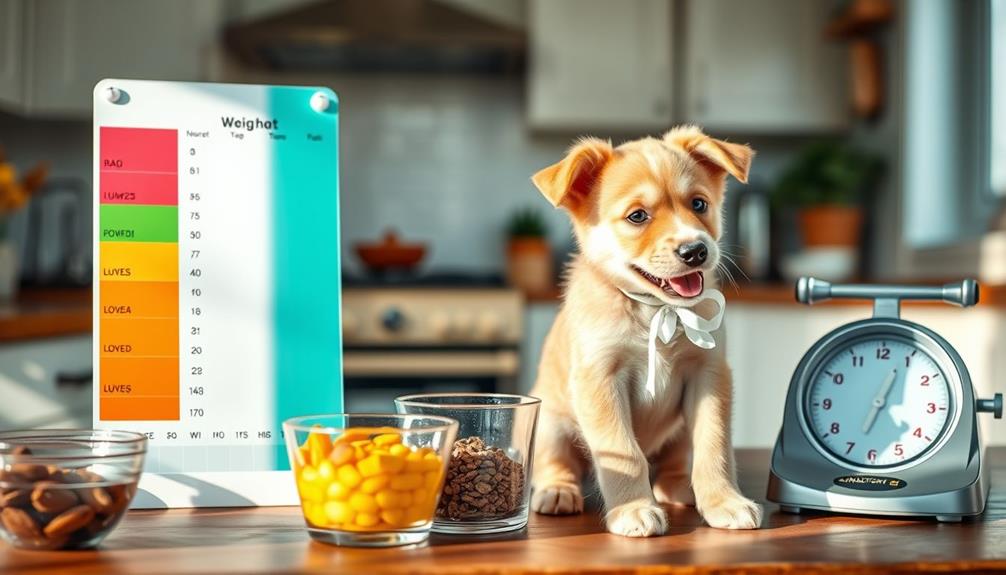
As your furry friend grows, adjusting their food intake is essential for healthy development. Monitoring your puppy's weight weekly helps you determine how much to feed them.
Younger puppies may need up to 10% of their body weight in raw feeding, while older pups require about 4-6% as they approach adulthood. It's also important to guarantee that your puppy's diet is balanced and includes vital nutrients, as a proper diet will support overall health and development, including their immune system and energy levels.
Consider incorporating natural supplements, such as essential oils for health benefits, to enhance their well-being.
- Shift feeding frequency from 4 meals at 8-16 weeks to 2-3 meals by 12-18 months.
- Adjust daily food based on age-specific needs and activity level.
- Keep an eye on your puppy's body condition score for ideal health.
As your puppy matures, it's significant to adjust food portions to maintain their ideal body condition.
Younger puppies require a higher caloric intake to support their rapid growth, while more active puppies may need additional food compared to their less active peers.
Always verify your puppy has a defined waist and visible ribs to gauge if you're providing the right amount of food. By regularly monitoring their weight and adjusting food as needed, you'll help your puppy grow into a healthy, happy adult.
Monitoring Weight and Health
Maintaining your puppy's health hinges on consistent monitoring of their weight and overall condition. Weigh your puppy weekly to track growth and guarantee they're within the ideal weight range for their breed and age. This regular monitoring weight helps you make necessary adjustments to their diet.
Additionally, just as individuals with BPD often experience intense emotional responses, puppies may exhibit varying energy levels that can influence their nutritional needs.
As a pet parent, you'll want to adjust food portions based on your puppy's activity level. More active puppies often require increased food intake, while less active ones may need less. Additionally, keep an eye on your puppy's body condition score; look for a defined waist and visible ribs to gauge if you're feeding the right amounts.
Pay attention to your puppy's coat and skin health, too. A shiny coat and non-itchy skin indicate balanced nutrition and proper feeding. If your puppy starts begging for food after meals, it's a sign that their portion size might need reassessment.
Benefits of a Raw Diet

Switching to a raw diet can offer numerous benefits for your puppy's health and well-being. By choosing this feeding method, you're not just providing food; you're enhancing their overall vitality and growth.
Here are some key benefits you can expect:
- Improved nutrient absorption, essential for your puppy's rapid growth, as a healthy skin and coat are also influenced by their diet.
- Enhanced energy levels, keeping your pup active and playful.
- Healthier skin and a shinier coat, often noticeable within weeks.
A raw diet is particularly beneficial for puppies, as it supports their developmental needs. You'll likely see improved nutrient absorption, which is fundamental during this growth phase.
Plus, many puppies with dietary restrictions experience reduced allergens and food sensitivities, making mealtime less of a hassle.
Chewing on raw foods also promotes dental health by naturally reducing plaque and tartar buildup.
Your puppy's energy levels will likely soar, helping them maintain a balanced energy throughout the day.
With all these advantages, a raw diet could be the perfect choice for your furry friend!
Transitioning to Raw Food

Shifting your puppy to a raw food diet can be an exciting yet careful process. Start by gradually altering to raw food over a week. Mix small amounts of raw food with your puppy's current diet to avoid digestive upset. Aim to replace 25% of the current diet with raw food in the first few days, then gradually increase to 100% by the end of the week.
Monitor your puppy's weight, energy levels, and stool consistency during this change. Introduce new proteins one at a time, allowing a few days in between to check for any allergic reactions or intolerance. Confirm the raw diet is balanced, incorporating muscle meat, edible bone, liver, and vegetables to meet your puppy's growth needs.
Here's a quick overview of how to change:
| Day | Current Food | Raw Food |
|---|---|---|
| 1-2 | 75% | 25% |
| 3-4 | 50% | 50% |
| 5-6 | 25% | 75% |
| 7 | 0% | 100% |
Through this careful process, you'll establish a healthy raw diet that supports your puppy's development.
Frequently Asked Questions
How Do You Calculate Puppy Food Portions?
To calculate puppy food portions, start by weighing your puppy. For ages 8 to 16 weeks, feed about 10% of their weight; after that, adjust to 4% as they grow and slow down.
How Much to Feed a Puppy Chart?
You should refer to a puppy feeding chart that outlines daily food amounts based on your puppy's age and weight. Adjust portions regularly, considering their growth and activity level for best health and development.
How Do You Calculate Portions of Homemade Dog Food?
To calculate portions of homemade dog food, just think of it like preparing a special meal. You'll want to feed 5-6% of your puppy's weight daily, adjusting as they grow. Keep monitoring their progress!
Conclusion
In summary, calculating the right amount of raw food for your puppy is essential for their growth and health. For instance, imagine a Golden Retriever puppy, Max, who thrived on a balanced raw diet—his coat became shinier, energy levels soared, and he developed strong muscles. By following the steps outlined, you can guarantee your furry friend gets the nutrition they need to thrive. Remember, a healthy puppy today means a happy dog tomorrow!

